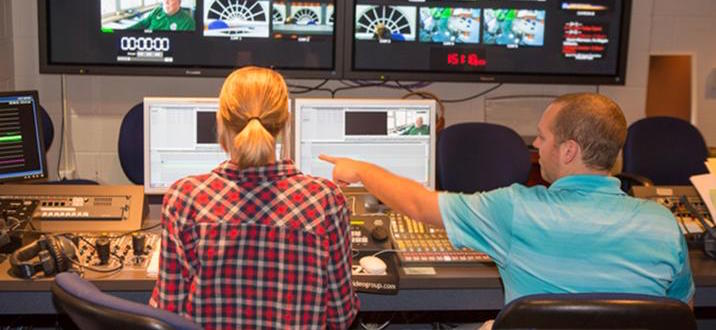
Frequently Asked Questions
The student will present the required information in a manila folder to the main SMAD office. Print the student's last name, first name and student identification number on the tab of the folder. The student must supply the folder.
Following the review by the SMAD Admission Committee, students will be notified about their acceptance into the major. If accepted, students will be eligible to register for SMAD courses starting the following semester. Students not accepted into the major will be notified and may reapply the following January or in a later January. Fall notifications typically occur between late-September and mid-October and Spring notifications typically occur in mid-March during Spring Break.
Declaring a SMAD major does not guarantee the student will be fully admitted into the SMAD major.
A declared SMAD student may take SMAD 101, but the student is restricted from SMAD courses beyond SMAD 101 until he or she is fully admitted into the major.
Yes. Because admission to SMAD is not guaranteed, it is a good idea to have another major in mind in case you are not fully admitted to the major. For sophomores who have completed General Education and B.A./B.S. requirements, it is usually a good idea to start work in another major during the application process.
Because SMAD is a relatively small major (at 36 credit hours), many students have either a second major or a minor, although neither is required. Checking with your SMAD advisor and with an advisor in a second major or minor is essential to planning for a timely graduation.
No. SMAD internships are available only to fully admitted students who meet certain criteria.
Most SMAD-affiliated clubs, organizations and activities allow for non-SMAD majors to participate. Contact individual clubs and organizations for details.
SMAD majors may choose a Bachelor of Arts or a Bachelor of Science Degree.
Those choosing the B.A. are required to take a foreign language through the intermediate (232) level and a Philosophy course in addition to any Philosophy course taken to satisfy General Education requirements (PHIL 120 and 150 do not count for the B.A. requirement). The number of courses needed for the completion of the B.A. will vary based on the student's Foreign Language Placement Exam scores.
Those choosing the B.S. take an additional course in Scientific Literacy and an additional course in Quantitative Literacy (Math) beyond courses required for General Education.
From the SMAD major perspective, elective credits are any credits that do not fulfill major requirements. Courses found on the General Education checklist, courses taken for a second major or minor, or courses outside of one of those structures would count as elective credit. Simply stated, JMU students need 120 credit hours for graduation and SMAD majors need 78 credit hours outside of the major. Those 78 may be filled with General Education requirements, BA/BS requirements, second major/minor courses, or “other” courses outside of the major.
Please ensure that your major/minor/pre-professional program is correct. Then, make an appointment to meet with your advisor to discuss your Academic Requirements report. If there are changes or adjustments that need to be made, you or your advisor may to send an email to registrar@jmu.edu. Note that if you have received a senior evaluation following the application for graduation, please refer to that document instead of your Academic Requirements report.
Most academic policies originate from the Office of the Registrar. Here students will find a full academic calendar, exam schedules, enrollment dates and deadlines, graduation application procedures and forms, registration tutorials, and forms for leaving, returning to, or transferring credits to JMU.
Academic planning can vary greatly based on individual student careers and when students start the major, but the general rule is that the SMAD major can be completed in four semesters following admission to the major. So, if a student was admitted during the spring term of his or her sophomore year, graduation by the end of his or her senior year should not be a problem. While this is a generally accepted timeline, regular meetings with an advisor are recommended to ensure students are “on track.”
Students who wish to change concentrations after being accepted into the major may apply to do so only during the January application period. Students seeking this option are required to submit:
- A letter to the Admission Committee of no more than 2 pages in length
- Complete the Change of Concentration Form
A student will be permitted to change concentrations only after consulting with his or her advisor and gaining approval from the admissions committee. Admission into a new concentration is not guaranteed. Contact the SMAD main office for more information.
Because SMAD is a relatively small major (at 36 credit hours), many students elect to add a second major or a minor, although neither is required. Checking with your SMAD advisor and with an advisor in a second major or minor is essential to planning for a timely graduation.
Many SMAD majors have a Mac, and the SMAD department has only Mac labs, but student ownership of a Mac is not a requirement for success in the major. SMAD labs are available for student use and provide access to all necessary hardware and software for student projects.
SMAD considers requests for transfer credit from other institutions, but only for pre-approved classes. In other words, students must submit the paperwork and get approval before taking the class for which they are requesting credit.
Only in very rare instances does SMAD give credit for lab, writing and production classes. When credit is given, it will usually be for equivalent crticial/analytical classes. In some cases, SMAD 000 credit may be given. SMAD 000 credit will give you credits toward the 120 hours you need to graduate from JMU, but will not satisfy requirements for SMAD or substitute for some other required class in our curriculum.

STEP 1: Pick up a PERMISSION TO TAKE COURSES FOR TRANSFER CREDIT form in the SMAD office in Harrison 0276 or click on the image link to the left to download and print a copy.
STEP 2: Fill out the form completely, indicating the course number of the class or classes from other institutions and the SMAD course/credit you are requesting. If no specific SMAD class seems to apply, you may request SMAD 000 credit.
STEP 3: Acquire a COURSE SYLLABUS or other detailed information about the course content. This should be more than simply the class description from a course catalog. It should include information about course topics from week-to-week, assignments, grading criteria, the number of hours the class meets each week and the number of weeks in the semester. Failure to provide this information will result in a rejection of credit.
STEP 4: Bring the PERMISSION TO TAKE COURSES FOR TRANSFER CREDIT form and the COURSE SYLLABUS, along with any other supporting documentation, to the main SMAD office in Harrison 0276. SMAD will review your material within approximately a week to two weeks.
STEP 5: Call the SMAD office (540-568-7007) and ask if your form is ready to be picked up. If ready, pick up the form in the SMAD office and take it to the Registrar's office.
Download the SMAD Internship Packet (PDF).
Of the 120 hours of course work required for graduation, a student may count no more than six hours of combined credit in SMAD 295 and SMAD 395, Practicums; SMAD 390, Directed Projects, and SMAD 495, Internship, toward a major in media arts and design.
